Meta-Analysis: How Teacher Media Literacy Affects Digital Integration
VerifiedAdded on 2023/06/09
|18
|5686
|202
Report
AI Summary
This report presents a meta-analysis exploring the impact of teacher media literacy on the integration of digital media into the classroom. It begins by formulating a research question and outlining the selection criteria for relevant studies, focusing on pedagogical learning, digital media, and collaborative approaches to contemporary education. The analysis encompasses a literature search and study selection, examining context-specific factors, educational models, learning environments, ICT integration, research in digital learning, classroom integration challenges, and the role of media literacy in teaching strategies. Methodologically, the report discusses content analysis, task-based methods, quasi-experiments, socio-cultural action-based models, systematic studies, and comparative analyses. The results and discussion section synthesizes findings from various studies, ultimately concluding on the significance of media literacy in enhancing the effectiveness of digital media integration within educational settings. The report also highlights the challenges and opportunities associated with digital learning and emphasizes the need for teachers to acquire ICT skills and digital competencies to facilitate meaningful learning experiences.

Meta Analysis
How does the media literacy of the teacher affect the integration of digital media into the
classroom?”
Keywords: Distance education; media literacy; content analyis; integration of digital media,
digital teaching approaches
How does the media literacy of the teacher affect the integration of digital media into the
classroom?”
Keywords: Distance education; media literacy; content analyis; integration of digital media,
digital teaching approaches
Paraphrase This Document
Need a fresh take? Get an instant paraphrase of this document with our AI Paraphraser

Abstract
The era of distance education became popular because of the spread of the internet and the
benefits of the online environment. Media literacy continues to inspire learners and instructors
to seek economic benefits of the digital enviroonment. Content analysis reveals the integration
of digital media in digital teaching approaches for strategic educational experiences. The need
to connect instructors to learners motivates the redesigning of classrrom content and
acquisition of teaching competencies. Although open learning has a large rate of adoption,
there are concerns about effective integration of the digital media in learning. As part of social
change, digital media continues to shape teaching strategies and the classroom experience. In
higher education, it is effective in research and academic subjects. Connecting digital media
to teaching and learning calls for the acquisition of ICT skills and digital competencies. The
social impact of digital media also influences the contemporary teachers attitude towards open
learning. This meta analysis compares studies on the integration of digital media in the
classroom and professional teaching methods to media literacy.
The era of distance education became popular because of the spread of the internet and the
benefits of the online environment. Media literacy continues to inspire learners and instructors
to seek economic benefits of the digital enviroonment. Content analysis reveals the integration
of digital media in digital teaching approaches for strategic educational experiences. The need
to connect instructors to learners motivates the redesigning of classrrom content and
acquisition of teaching competencies. Although open learning has a large rate of adoption,
there are concerns about effective integration of the digital media in learning. As part of social
change, digital media continues to shape teaching strategies and the classroom experience. In
higher education, it is effective in research and academic subjects. Connecting digital media
to teaching and learning calls for the acquisition of ICT skills and digital competencies. The
social impact of digital media also influences the contemporary teachers attitude towards open
learning. This meta analysis compares studies on the integration of digital media in the
classroom and professional teaching methods to media literacy.
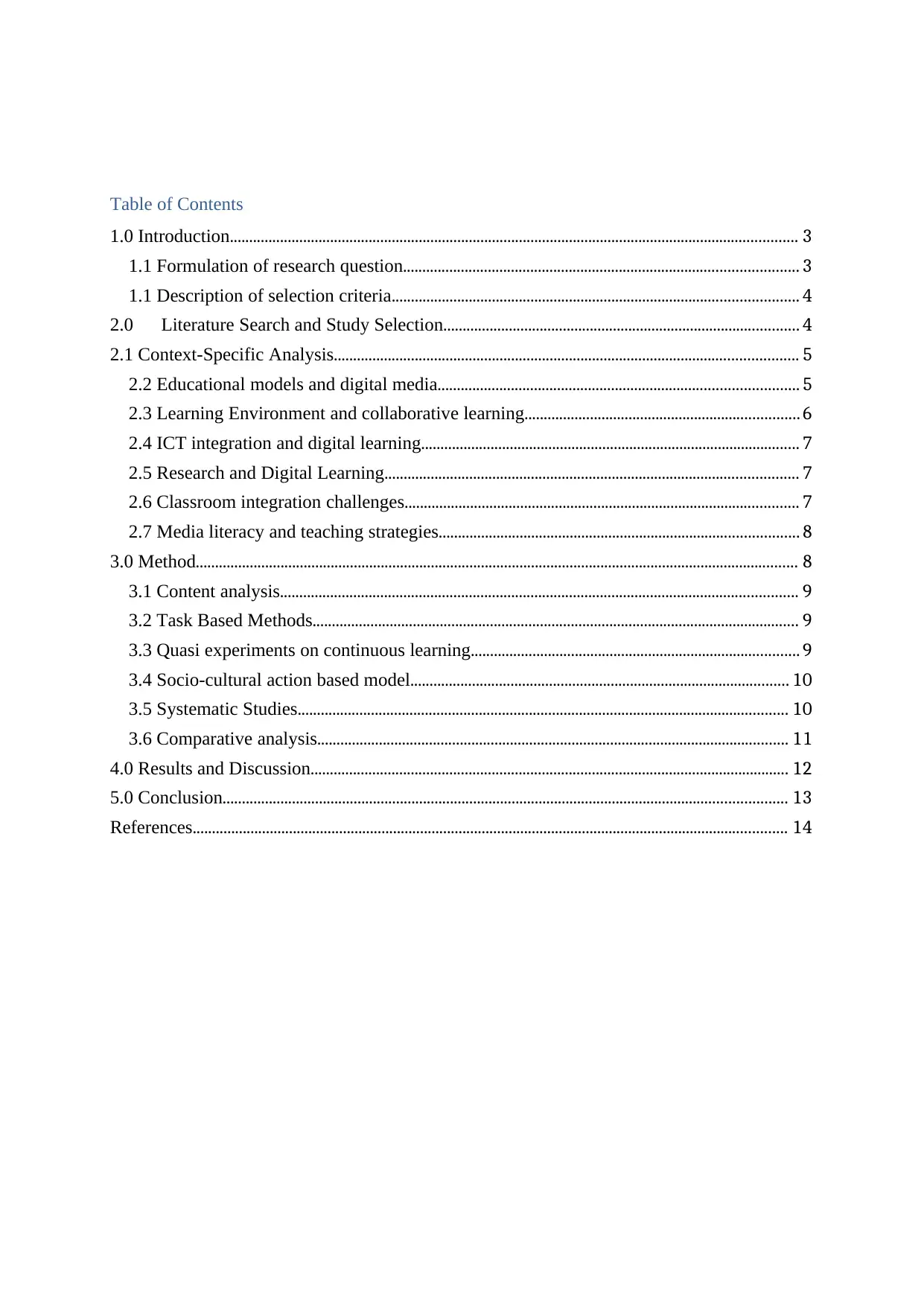
Table of Contents
1.0 Introduction................................................................................................................................................... 3
1.1 Formulation of research question...................................................................................................... 3
1.1 Description of selection criteria......................................................................................................... 4
2.0 Literature Search and Study Selection............................................................................................ 4
2.1 Context-Specific Analysis........................................................................................................................ 5
2.2 Educational models and digital media............................................................................................. 5
2.3 Learning Environment and collaborative learning.......................................................................6
2.4 ICT integration and digital learning.................................................................................................. 7
2.5 Research and Digital Learning........................................................................................................... 7
2.6 Classroom integration challenges...................................................................................................... 7
2.7 Media literacy and teaching strategies............................................................................................. 8
3.0 Method............................................................................................................................................................ 8
3.1 Content analysis...................................................................................................................................... 9
3.2 Task Based Methods.............................................................................................................................. 9
3.3 Quasi experiments on continuous learning..................................................................................... 9
3.4 Socio-cultural action based model.................................................................................................. 10
3.5 Systematic Studies............................................................................................................................... 10
3.6 Comparative analysis.......................................................................................................................... 11
4.0 Results and Discussion............................................................................................................................ 12
5.0 Conclusion.................................................................................................................................................. 13
References.......................................................................................................................................................... 14
1.0 Introduction................................................................................................................................................... 3
1.1 Formulation of research question...................................................................................................... 3
1.1 Description of selection criteria......................................................................................................... 4
2.0 Literature Search and Study Selection............................................................................................ 4
2.1 Context-Specific Analysis........................................................................................................................ 5
2.2 Educational models and digital media............................................................................................. 5
2.3 Learning Environment and collaborative learning.......................................................................6
2.4 ICT integration and digital learning.................................................................................................. 7
2.5 Research and Digital Learning........................................................................................................... 7
2.6 Classroom integration challenges...................................................................................................... 7
2.7 Media literacy and teaching strategies............................................................................................. 8
3.0 Method............................................................................................................................................................ 8
3.1 Content analysis...................................................................................................................................... 9
3.2 Task Based Methods.............................................................................................................................. 9
3.3 Quasi experiments on continuous learning..................................................................................... 9
3.4 Socio-cultural action based model.................................................................................................. 10
3.5 Systematic Studies............................................................................................................................... 10
3.6 Comparative analysis.......................................................................................................................... 11
4.0 Results and Discussion............................................................................................................................ 12
5.0 Conclusion.................................................................................................................................................. 13
References.......................................................................................................................................................... 14
⊘ This is a preview!⊘
Do you want full access?
Subscribe today to unlock all pages.

Trusted by 1+ million students worldwide
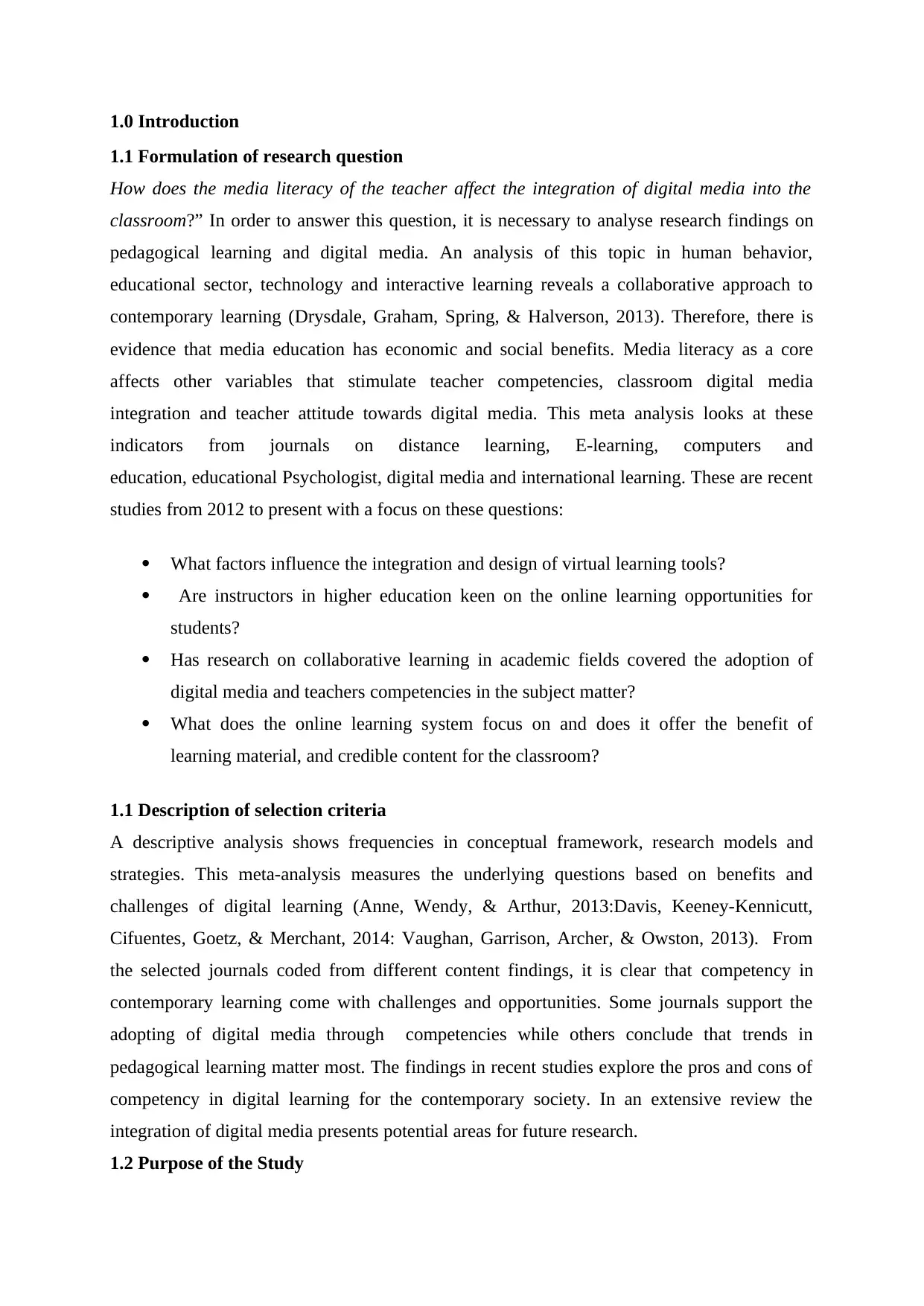
1.0 Introduction
1.1 Formulation of research question
How does the media literacy of the teacher affect the integration of digital media into the
classroom?” In order to answer this question, it is necessary to analyse research findings on
pedagogical learning and digital media. An analysis of this topic in human behavior,
educational sector, technology and interactive learning reveals a collaborative approach to
contemporary learning (Drysdale, Graham, Spring, & Halverson, 2013). Therefore, there is
evidence that media education has economic and social benefits. Media literacy as a core
affects other variables that stimulate teacher competencies, classroom digital media
integration and teacher attitude towards digital media. This meta analysis looks at these
indicators from journals on distance learning, E-learning, computers and
education, educational Psychologist, digital media and international learning. These are recent
studies from 2012 to present with a focus on these questions:
What factors influence the integration and design of virtual learning tools?
Are instructors in higher education keen on the online learning opportunities for
students?
Has research on collaborative learning in academic fields covered the adoption of
digital media and teachers competencies in the subject matter?
What does the online learning system focus on and does it offer the benefit of
learning material, and credible content for the classroom?
1.1 Description of selection criteria
A descriptive analysis shows frequencies in conceptual framework, research models and
strategies. This meta-analysis measures the underlying questions based on benefits and
challenges of digital learning (Anne, Wendy, & Arthur, 2013:Davis, Keeney-Kennicutt,
Cifuentes, Goetz, & Merchant, 2014: Vaughan, Garrison, Archer, & Owston, 2013). From
the selected journals coded from different content findings, it is clear that competency in
contemporary learning come with challenges and opportunities. Some journals support the
adopting of digital media through competencies while others conclude that trends in
pedagogical learning matter most. The findings in recent studies explore the pros and cons of
competency in digital learning for the contemporary society. In an extensive review the
integration of digital media presents potential areas for future research.
1.2 Purpose of the Study
1.1 Formulation of research question
How does the media literacy of the teacher affect the integration of digital media into the
classroom?” In order to answer this question, it is necessary to analyse research findings on
pedagogical learning and digital media. An analysis of this topic in human behavior,
educational sector, technology and interactive learning reveals a collaborative approach to
contemporary learning (Drysdale, Graham, Spring, & Halverson, 2013). Therefore, there is
evidence that media education has economic and social benefits. Media literacy as a core
affects other variables that stimulate teacher competencies, classroom digital media
integration and teacher attitude towards digital media. This meta analysis looks at these
indicators from journals on distance learning, E-learning, computers and
education, educational Psychologist, digital media and international learning. These are recent
studies from 2012 to present with a focus on these questions:
What factors influence the integration and design of virtual learning tools?
Are instructors in higher education keen on the online learning opportunities for
students?
Has research on collaborative learning in academic fields covered the adoption of
digital media and teachers competencies in the subject matter?
What does the online learning system focus on and does it offer the benefit of
learning material, and credible content for the classroom?
1.1 Description of selection criteria
A descriptive analysis shows frequencies in conceptual framework, research models and
strategies. This meta-analysis measures the underlying questions based on benefits and
challenges of digital learning (Anne, Wendy, & Arthur, 2013:Davis, Keeney-Kennicutt,
Cifuentes, Goetz, & Merchant, 2014: Vaughan, Garrison, Archer, & Owston, 2013). From
the selected journals coded from different content findings, it is clear that competency in
contemporary learning come with challenges and opportunities. Some journals support the
adopting of digital media through competencies while others conclude that trends in
pedagogical learning matter most. The findings in recent studies explore the pros and cons of
competency in digital learning for the contemporary society. In an extensive review the
integration of digital media presents potential areas for future research.
1.2 Purpose of the Study
Paraphrase This Document
Need a fresh take? Get an instant paraphrase of this document with our AI Paraphraser

Teachers take advantage of the emerging digital trends such as web-based learning for
progressive professional development and change in the classroom. This study explores ways
in which media literacy affects teacher’s professional development and how this affects the
integration of digital media in the classroom.
2.1 Context-Specific Analysis
Widespread research findings by Bozkurt et al (2015) explain that in 2009-2013, there has
been a shift in education. In a study featuring 861 article reviews, it was evident that there are
variables, which influence the adoption of digital media competencies. Among these are the
educational opportunities and learners attitudes towards digital learning. In order to
understand the impact of digital media on learning, it is necessary to understand its
contribution to the contemporary society. In this analysis, the learning outcome indicates the
importance of using smart principles for instructional design of learning material. Media in
pedagogical learning captures the learning environment and a reality-based model of
knowledge delivery. The content and technology tool is an integral part of this process. In this
study, the internet comes out as a learning tool instead of a communication tool. However, the
research identifies gaps on how to integrate digital media in the academic workspace, sharing
academic course content and independent learning. Does social media a common part of
online learning, help students to acquire good grades? Is it a platform for making friends as
well as obtaining serious learning material? Does digital media support positive feedback
from students in the learning process?
2.2 Educational models and digital media
Learning outcome is one of the indicators of successful integration of digital media in the
classroom. Primary data from the Substitution, augmentation, modification and redefinition
model (SAMR) presents reviews on mobile learning activities (Romrell, Kidder, & Wood,
2014). In this study, mobile phones are a significant part of social learning and
communication. This study raises questions about challenges of implementing digital learning
in a personalised setting an educational perspective. The learning framework indicates both
formal and informal context. In the article, learning is a process influenced by a variety of
factors including the economic, social and technological. E-books, online games, videos,
mobile communication, social media and libraries become effective tools for spreading
education. This perspective considers the use of multimedia platforms for sharing knowledge.
In this case, technology has an ability to support learning as much as the individual cognitive
progressive professional development and change in the classroom. This study explores ways
in which media literacy affects teacher’s professional development and how this affects the
integration of digital media in the classroom.
2.1 Context-Specific Analysis
Widespread research findings by Bozkurt et al (2015) explain that in 2009-2013, there has
been a shift in education. In a study featuring 861 article reviews, it was evident that there are
variables, which influence the adoption of digital media competencies. Among these are the
educational opportunities and learners attitudes towards digital learning. In order to
understand the impact of digital media on learning, it is necessary to understand its
contribution to the contemporary society. In this analysis, the learning outcome indicates the
importance of using smart principles for instructional design of learning material. Media in
pedagogical learning captures the learning environment and a reality-based model of
knowledge delivery. The content and technology tool is an integral part of this process. In this
study, the internet comes out as a learning tool instead of a communication tool. However, the
research identifies gaps on how to integrate digital media in the academic workspace, sharing
academic course content and independent learning. Does social media a common part of
online learning, help students to acquire good grades? Is it a platform for making friends as
well as obtaining serious learning material? Does digital media support positive feedback
from students in the learning process?
2.2 Educational models and digital media
Learning outcome is one of the indicators of successful integration of digital media in the
classroom. Primary data from the Substitution, augmentation, modification and redefinition
model (SAMR) presents reviews on mobile learning activities (Romrell, Kidder, & Wood,
2014). In this study, mobile phones are a significant part of social learning and
communication. This study raises questions about challenges of implementing digital learning
in a personalised setting an educational perspective. The learning framework indicates both
formal and informal context. In the article, learning is a process influenced by a variety of
factors including the economic, social and technological. E-books, online games, videos,
mobile communication, social media and libraries become effective tools for spreading
education. This perspective considers the use of multimedia platforms for sharing knowledge.
In this case, technology has an ability to support learning as much as the individual cognitive
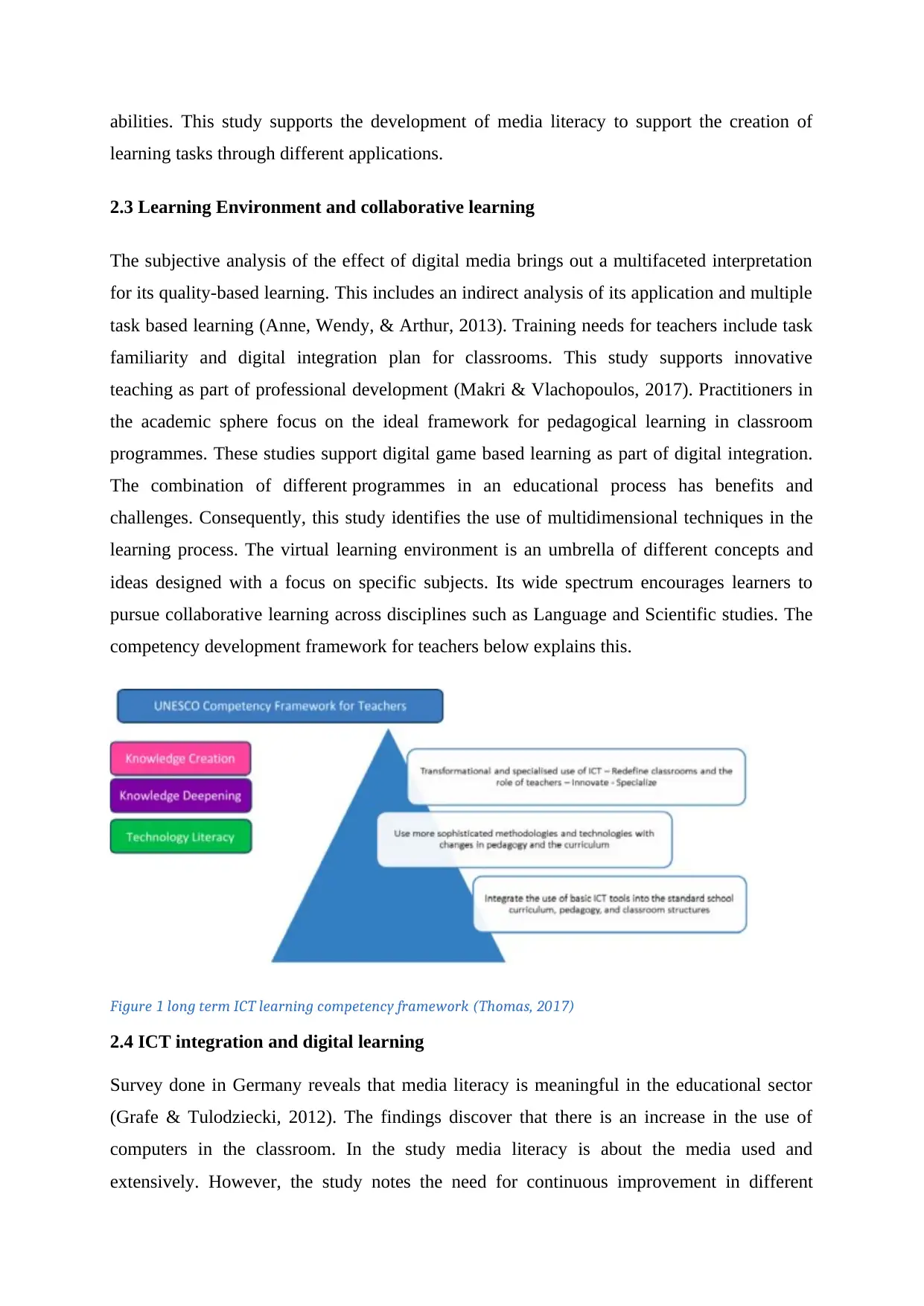
abilities. This study supports the development of media literacy to support the creation of
learning tasks through different applications.
2.3 Learning Environment and collaborative learning
The subjective analysis of the effect of digital media brings out a multifaceted interpretation
for its quality-based learning. This includes an indirect analysis of its application and multiple
task based learning (Anne, Wendy, & Arthur, 2013). Training needs for teachers include task
familiarity and digital integration plan for classrooms. This study supports innovative
teaching as part of professional development (Makri & Vlachopoulos, 2017). Practitioners in
the academic sphere focus on the ideal framework for pedagogical learning in classroom
programmes. These studies support digital game based learning as part of digital integration.
The combination of different programmes in an educational process has benefits and
challenges. Consequently, this study identifies the use of multidimensional techniques in the
learning process. The virtual learning environment is an umbrella of different concepts and
ideas designed with a focus on specific subjects. Its wide spectrum encourages learners to
pursue collaborative learning across disciplines such as Language and Scientific studies. The
competency development framework for teachers below explains this.
Figure 1 long term ICT learning competency framework (Thomas, 2017)
2.4 ICT integration and digital learning
Survey done in Germany reveals that media literacy is meaningful in the educational sector
(Grafe & Tulodziecki, 2012). The findings discover that there is an increase in the use of
computers in the classroom. In the study media literacy is about the media used and
extensively. However, the study notes the need for continuous improvement in different
learning tasks through different applications.
2.3 Learning Environment and collaborative learning
The subjective analysis of the effect of digital media brings out a multifaceted interpretation
for its quality-based learning. This includes an indirect analysis of its application and multiple
task based learning (Anne, Wendy, & Arthur, 2013). Training needs for teachers include task
familiarity and digital integration plan for classrooms. This study supports innovative
teaching as part of professional development (Makri & Vlachopoulos, 2017). Practitioners in
the academic sphere focus on the ideal framework for pedagogical learning in classroom
programmes. These studies support digital game based learning as part of digital integration.
The combination of different programmes in an educational process has benefits and
challenges. Consequently, this study identifies the use of multidimensional techniques in the
learning process. The virtual learning environment is an umbrella of different concepts and
ideas designed with a focus on specific subjects. Its wide spectrum encourages learners to
pursue collaborative learning across disciplines such as Language and Scientific studies. The
competency development framework for teachers below explains this.
Figure 1 long term ICT learning competency framework (Thomas, 2017)
2.4 ICT integration and digital learning
Survey done in Germany reveals that media literacy is meaningful in the educational sector
(Grafe & Tulodziecki, 2012). The findings discover that there is an increase in the use of
computers in the classroom. In the study media literacy is about the media used and
extensively. However, the study notes the need for continuous improvement in different
⊘ This is a preview!⊘
Do you want full access?
Subscribe today to unlock all pages.

Trusted by 1+ million students worldwide

learning environments. In support of this, a quasi-experiment on the integration of
collaborative learning with computer technology as a problem solving approach to teaching
(Wagner, et al., 2013). The data analysis looks at the effectiveness of instructional learning
and competency development for autonomy and quality based learning. From this, content is
an important aspect of collaborative learning. It looks at the computer supported, web
oriented, video and software applications as some of the most common and effective methods
integrated in digital learning.
2.5 Research and Digital Learning
Research reviews on educator’s attitudes and collaboration skills in the classroom highlights
media literacy in contemporary society (Tuzel & Hobbs, 2015). Using a survey sample of
2820, this study identifies motivational factors that shape teacher’s attitudes to digital media.
Media literacy as a factor in digital learning is important when exploring conceivable ideas in
this context. Educators improve on learning and academic qualifications for effectiveness.
Unlike the face-to-face instructional model, digital techniques call for familiarization and in-
depth learning. Research interpretation and analytical skills enhance the digital analysis of
theoretical concepts and learning outcomes. In support of digital experience is the role of
digital learning and visual forms (Aston, Selwyn, & Henderson, 2017). In addition, this
research delves into the effectiveness of digital learning in research lays an emphasis on the
relevance of the material and the confidence it gives to the learner.
2.6 Classroom integration challenges
Bos, Eickelmann, & Gerick (2017) present a research paper with data from questionaires to
analyse the school level factors supporting or limiting ICT competenices. The findings draw
from a sample size made up of teachers and students as participants. The multilevel approach
covers infromation from Czech Republic, Norway, Germany and Australia. It international
influence in the adoption of ICT skills and techniques in the classroom. Educational activities
include in class and out of class activities. Lack of credibility makes content from sites such
as Twitter, Facebook and Google+ unfit for academic purposes. The inability to classify
social media into categories makes it difficult to place academic restrictions on it as a
platform for learning. In this analysis, learning activities capitalize on smartphones for
capturing screen shots, laptops and mobile technology for learning. In active learning, social
media supports collaborative learning in contemporary studies. It is also effective in
interactive learning because it engages students. The internet provides a platform for
collaborative learning with computer technology as a problem solving approach to teaching
(Wagner, et al., 2013). The data analysis looks at the effectiveness of instructional learning
and competency development for autonomy and quality based learning. From this, content is
an important aspect of collaborative learning. It looks at the computer supported, web
oriented, video and software applications as some of the most common and effective methods
integrated in digital learning.
2.5 Research and Digital Learning
Research reviews on educator’s attitudes and collaboration skills in the classroom highlights
media literacy in contemporary society (Tuzel & Hobbs, 2015). Using a survey sample of
2820, this study identifies motivational factors that shape teacher’s attitudes to digital media.
Media literacy as a factor in digital learning is important when exploring conceivable ideas in
this context. Educators improve on learning and academic qualifications for effectiveness.
Unlike the face-to-face instructional model, digital techniques call for familiarization and in-
depth learning. Research interpretation and analytical skills enhance the digital analysis of
theoretical concepts and learning outcomes. In support of digital experience is the role of
digital learning and visual forms (Aston, Selwyn, & Henderson, 2017). In addition, this
research delves into the effectiveness of digital learning in research lays an emphasis on the
relevance of the material and the confidence it gives to the learner.
2.6 Classroom integration challenges
Bos, Eickelmann, & Gerick (2017) present a research paper with data from questionaires to
analyse the school level factors supporting or limiting ICT competenices. The findings draw
from a sample size made up of teachers and students as participants. The multilevel approach
covers infromation from Czech Republic, Norway, Germany and Australia. It international
influence in the adoption of ICT skills and techniques in the classroom. Educational activities
include in class and out of class activities. Lack of credibility makes content from sites such
as Twitter, Facebook and Google+ unfit for academic purposes. The inability to classify
social media into categories makes it difficult to place academic restrictions on it as a
platform for learning. In this analysis, learning activities capitalize on smartphones for
capturing screen shots, laptops and mobile technology for learning. In active learning, social
media supports collaborative learning in contemporary studies. It is also effective in
interactive learning because it engages students. The internet provides a platform for
Paraphrase This Document
Need a fresh take? Get an instant paraphrase of this document with our AI Paraphraser
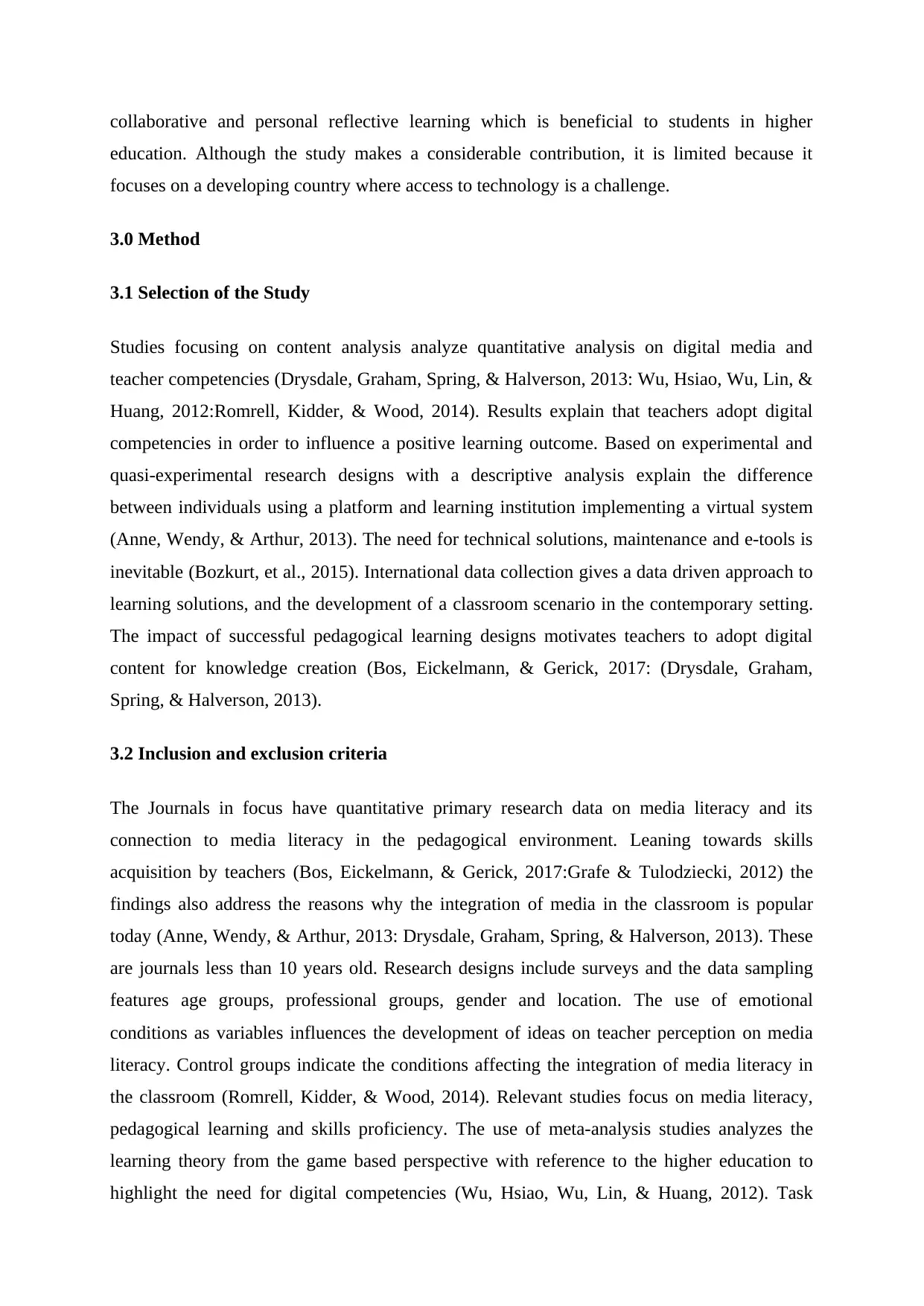
collaborative and personal reflective learning which is beneficial to students in higher
education. Although the study makes a considerable contribution, it is limited because it
focuses on a developing country where access to technology is a challenge.
3.0 Method
3.1 Selection of the Study
Studies focusing on content analysis analyze quantitative analysis on digital media and
teacher competencies (Drysdale, Graham, Spring, & Halverson, 2013: Wu, Hsiao, Wu, Lin, &
Huang, 2012:Romrell, Kidder, & Wood, 2014). Results explain that teachers adopt digital
competencies in order to influence a positive learning outcome. Based on experimental and
quasi-experimental research designs with a descriptive analysis explain the difference
between individuals using a platform and learning institution implementing a virtual system
(Anne, Wendy, & Arthur, 2013). The need for technical solutions, maintenance and e-tools is
inevitable (Bozkurt, et al., 2015). International data collection gives a data driven approach to
learning solutions, and the development of a classroom scenario in the contemporary setting.
The impact of successful pedagogical learning designs motivates teachers to adopt digital
content for knowledge creation (Bos, Eickelmann, & Gerick, 2017: (Drysdale, Graham,
Spring, & Halverson, 2013).
3.2 Inclusion and exclusion criteria
The Journals in focus have quantitative primary research data on media literacy and its
connection to media literacy in the pedagogical environment. Leaning towards skills
acquisition by teachers (Bos, Eickelmann, & Gerick, 2017:Grafe & Tulodziecki, 2012) the
findings also address the reasons why the integration of media in the classroom is popular
today (Anne, Wendy, & Arthur, 2013: Drysdale, Graham, Spring, & Halverson, 2013). These
are journals less than 10 years old. Research designs include surveys and the data sampling
features age groups, professional groups, gender and location. The use of emotional
conditions as variables influences the development of ideas on teacher perception on media
literacy. Control groups indicate the conditions affecting the integration of media literacy in
the classroom (Romrell, Kidder, & Wood, 2014). Relevant studies focus on media literacy,
pedagogical learning and skills proficiency. The use of meta-analysis studies analyzes the
learning theory from the game based perspective with reference to the higher education to
highlight the need for digital competencies (Wu, Hsiao, Wu, Lin, & Huang, 2012). Task
education. Although the study makes a considerable contribution, it is limited because it
focuses on a developing country where access to technology is a challenge.
3.0 Method
3.1 Selection of the Study
Studies focusing on content analysis analyze quantitative analysis on digital media and
teacher competencies (Drysdale, Graham, Spring, & Halverson, 2013: Wu, Hsiao, Wu, Lin, &
Huang, 2012:Romrell, Kidder, & Wood, 2014). Results explain that teachers adopt digital
competencies in order to influence a positive learning outcome. Based on experimental and
quasi-experimental research designs with a descriptive analysis explain the difference
between individuals using a platform and learning institution implementing a virtual system
(Anne, Wendy, & Arthur, 2013). The need for technical solutions, maintenance and e-tools is
inevitable (Bozkurt, et al., 2015). International data collection gives a data driven approach to
learning solutions, and the development of a classroom scenario in the contemporary setting.
The impact of successful pedagogical learning designs motivates teachers to adopt digital
content for knowledge creation (Bos, Eickelmann, & Gerick, 2017: (Drysdale, Graham,
Spring, & Halverson, 2013).
3.2 Inclusion and exclusion criteria
The Journals in focus have quantitative primary research data on media literacy and its
connection to media literacy in the pedagogical environment. Leaning towards skills
acquisition by teachers (Bos, Eickelmann, & Gerick, 2017:Grafe & Tulodziecki, 2012) the
findings also address the reasons why the integration of media in the classroom is popular
today (Anne, Wendy, & Arthur, 2013: Drysdale, Graham, Spring, & Halverson, 2013). These
are journals less than 10 years old. Research designs include surveys and the data sampling
features age groups, professional groups, gender and location. The use of emotional
conditions as variables influences the development of ideas on teacher perception on media
literacy. Control groups indicate the conditions affecting the integration of media literacy in
the classroom (Romrell, Kidder, & Wood, 2014). Relevant studies focus on media literacy,
pedagogical learning and skills proficiency. The use of meta-analysis studies analyzes the
learning theory from the game based perspective with reference to the higher education to
highlight the need for digital competencies (Wu, Hsiao, Wu, Lin, & Huang, 2012). Task
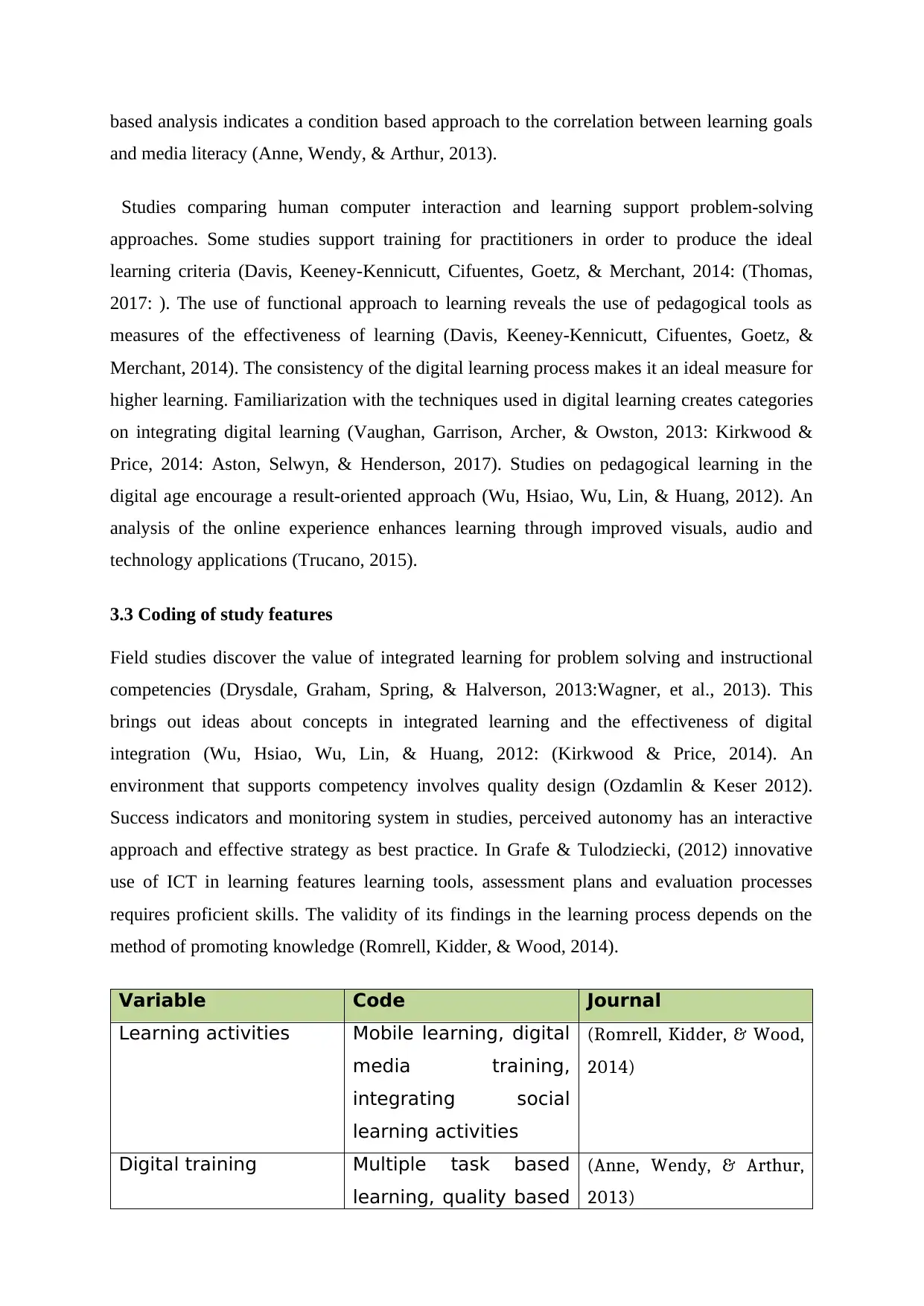
based analysis indicates a condition based approach to the correlation between learning goals
and media literacy (Anne, Wendy, & Arthur, 2013).
Studies comparing human computer interaction and learning support problem-solving
approaches. Some studies support training for practitioners in order to produce the ideal
learning criteria (Davis, Keeney-Kennicutt, Cifuentes, Goetz, & Merchant, 2014: (Thomas,
2017: ). The use of functional approach to learning reveals the use of pedagogical tools as
measures of the effectiveness of learning (Davis, Keeney-Kennicutt, Cifuentes, Goetz, &
Merchant, 2014). The consistency of the digital learning process makes it an ideal measure for
higher learning. Familiarization with the techniques used in digital learning creates categories
on integrating digital learning (Vaughan, Garrison, Archer, & Owston, 2013: Kirkwood &
Price, 2014: Aston, Selwyn, & Henderson, 2017). Studies on pedagogical learning in the
digital age encourage a result-oriented approach (Wu, Hsiao, Wu, Lin, & Huang, 2012). An
analysis of the online experience enhances learning through improved visuals, audio and
technology applications (Trucano, 2015).
3.3 Coding of study features
Field studies discover the value of integrated learning for problem solving and instructional
competencies (Drysdale, Graham, Spring, & Halverson, 2013:Wagner, et al., 2013). This
brings out ideas about concepts in integrated learning and the effectiveness of digital
integration (Wu, Hsiao, Wu, Lin, & Huang, 2012: (Kirkwood & Price, 2014). An
environment that supports competency involves quality design (Ozdamlin & Keser 2012).
Success indicators and monitoring system in studies, perceived autonomy has an interactive
approach and effective strategy as best practice. In Grafe & Tulodziecki, (2012) innovative
use of ICT in learning features learning tools, assessment plans and evaluation processes
requires proficient skills. The validity of its findings in the learning process depends on the
method of promoting knowledge (Romrell, Kidder, & Wood, 2014).
Variable Code Journal
Learning activities Mobile learning, digital
media training,
integrating social
learning activities
(Romrell, Kidder, & Wood,
2014)
Digital training Multiple task based
learning, quality based
(Anne, Wendy, & Arthur,
2013)
and media literacy (Anne, Wendy, & Arthur, 2013).
Studies comparing human computer interaction and learning support problem-solving
approaches. Some studies support training for practitioners in order to produce the ideal
learning criteria (Davis, Keeney-Kennicutt, Cifuentes, Goetz, & Merchant, 2014: (Thomas,
2017: ). The use of functional approach to learning reveals the use of pedagogical tools as
measures of the effectiveness of learning (Davis, Keeney-Kennicutt, Cifuentes, Goetz, &
Merchant, 2014). The consistency of the digital learning process makes it an ideal measure for
higher learning. Familiarization with the techniques used in digital learning creates categories
on integrating digital learning (Vaughan, Garrison, Archer, & Owston, 2013: Kirkwood &
Price, 2014: Aston, Selwyn, & Henderson, 2017). Studies on pedagogical learning in the
digital age encourage a result-oriented approach (Wu, Hsiao, Wu, Lin, & Huang, 2012). An
analysis of the online experience enhances learning through improved visuals, audio and
technology applications (Trucano, 2015).
3.3 Coding of study features
Field studies discover the value of integrated learning for problem solving and instructional
competencies (Drysdale, Graham, Spring, & Halverson, 2013:Wagner, et al., 2013). This
brings out ideas about concepts in integrated learning and the effectiveness of digital
integration (Wu, Hsiao, Wu, Lin, & Huang, 2012: (Kirkwood & Price, 2014). An
environment that supports competency involves quality design (Ozdamlin & Keser 2012).
Success indicators and monitoring system in studies, perceived autonomy has an interactive
approach and effective strategy as best practice. In Grafe & Tulodziecki, (2012) innovative
use of ICT in learning features learning tools, assessment plans and evaluation processes
requires proficient skills. The validity of its findings in the learning process depends on the
method of promoting knowledge (Romrell, Kidder, & Wood, 2014).
Variable Code Journal
Learning activities Mobile learning, digital
media training,
integrating social
learning activities
(Romrell, Kidder, & Wood,
2014)
Digital training Multiple task based
learning, quality based
(Anne, Wendy, & Arthur,
2013)
⊘ This is a preview!⊘
Do you want full access?
Subscribe today to unlock all pages.

Trusted by 1+ million students worldwide
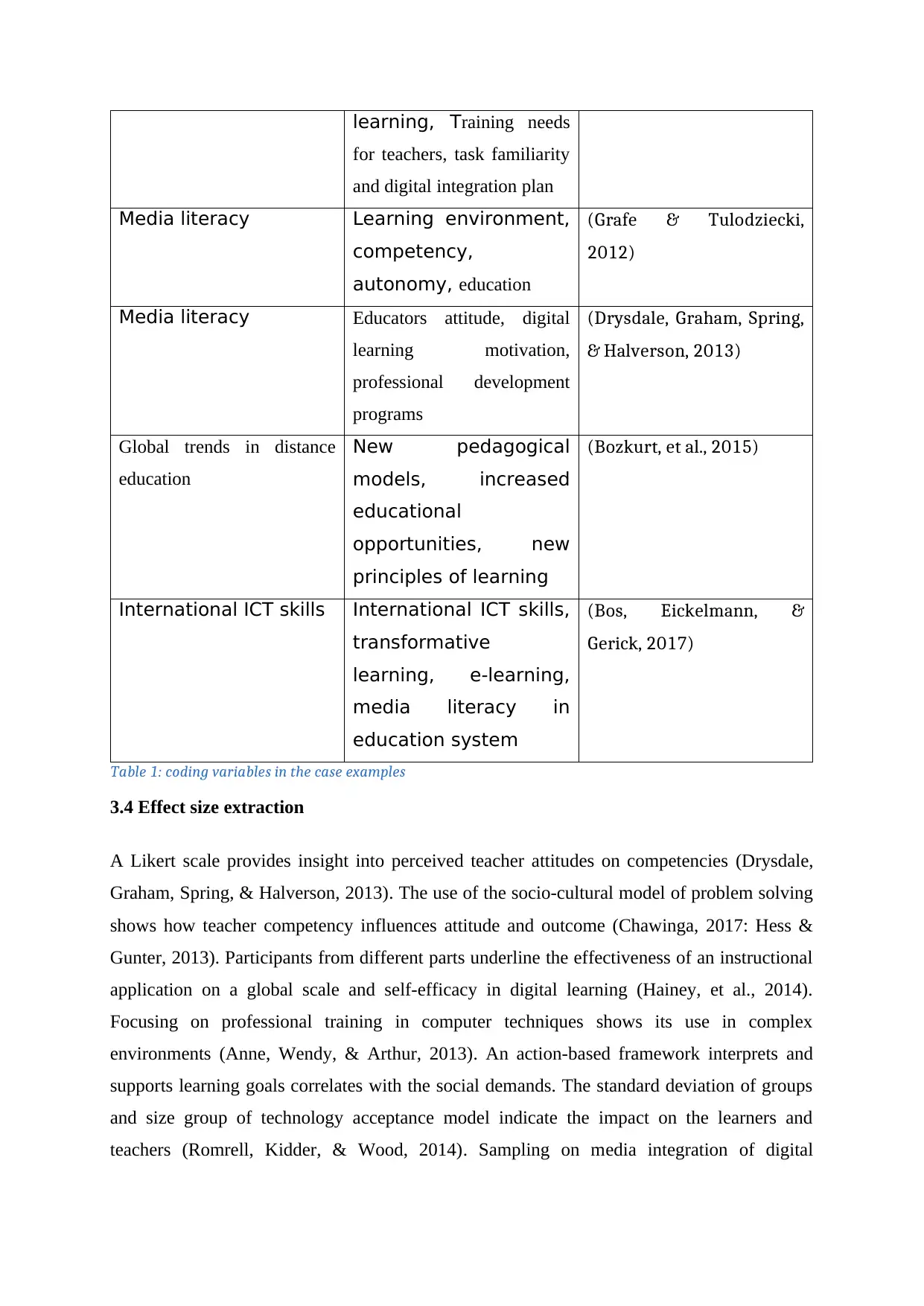
learning, Training needs
for teachers, task familiarity
and digital integration plan
Media literacy Learning environment,
competency,
autonomy, education
(Grafe & Tulodziecki,
2012)
Media literacy Educators attitude, digital
learning motivation,
professional development
programs
(Drysdale, Graham, Spring,
& Halverson, 2013)
Global trends in distance
education
New pedagogical
models, increased
educational
opportunities, new
principles of learning
(Bozkurt, et al., 2015)
International ICT skills International ICT skills,
transformative
learning, e-learning,
media literacy in
education system
(Bos, Eickelmann, &
Gerick, 2017)
Table 1: coding variables in the case examples
3.4 Effect size extraction
A Likert scale provides insight into perceived teacher attitudes on competencies (Drysdale,
Graham, Spring, & Halverson, 2013). The use of the socio-cultural model of problem solving
shows how teacher competency influences attitude and outcome (Chawinga, 2017: Hess &
Gunter, 2013). Participants from different parts underline the effectiveness of an instructional
application on a global scale and self-efficacy in digital learning (Hainey, et al., 2014).
Focusing on professional training in computer techniques shows its use in complex
environments (Anne, Wendy, & Arthur, 2013). An action-based framework interprets and
supports learning goals correlates with the social demands. The standard deviation of groups
and size group of technology acceptance model indicate the impact on the learners and
teachers (Romrell, Kidder, & Wood, 2014). Sampling on media integration of digital
for teachers, task familiarity
and digital integration plan
Media literacy Learning environment,
competency,
autonomy, education
(Grafe & Tulodziecki,
2012)
Media literacy Educators attitude, digital
learning motivation,
professional development
programs
(Drysdale, Graham, Spring,
& Halverson, 2013)
Global trends in distance
education
New pedagogical
models, increased
educational
opportunities, new
principles of learning
(Bozkurt, et al., 2015)
International ICT skills International ICT skills,
transformative
learning, e-learning,
media literacy in
education system
(Bos, Eickelmann, &
Gerick, 2017)
Table 1: coding variables in the case examples
3.4 Effect size extraction
A Likert scale provides insight into perceived teacher attitudes on competencies (Drysdale,
Graham, Spring, & Halverson, 2013). The use of the socio-cultural model of problem solving
shows how teacher competency influences attitude and outcome (Chawinga, 2017: Hess &
Gunter, 2013). Participants from different parts underline the effectiveness of an instructional
application on a global scale and self-efficacy in digital learning (Hainey, et al., 2014).
Focusing on professional training in computer techniques shows its use in complex
environments (Anne, Wendy, & Arthur, 2013). An action-based framework interprets and
supports learning goals correlates with the social demands. The standard deviation of groups
and size group of technology acceptance model indicate the impact on the learners and
teachers (Romrell, Kidder, & Wood, 2014). Sampling on media integration of digital
Paraphrase This Document
Need a fresh take? Get an instant paraphrase of this document with our AI Paraphraser
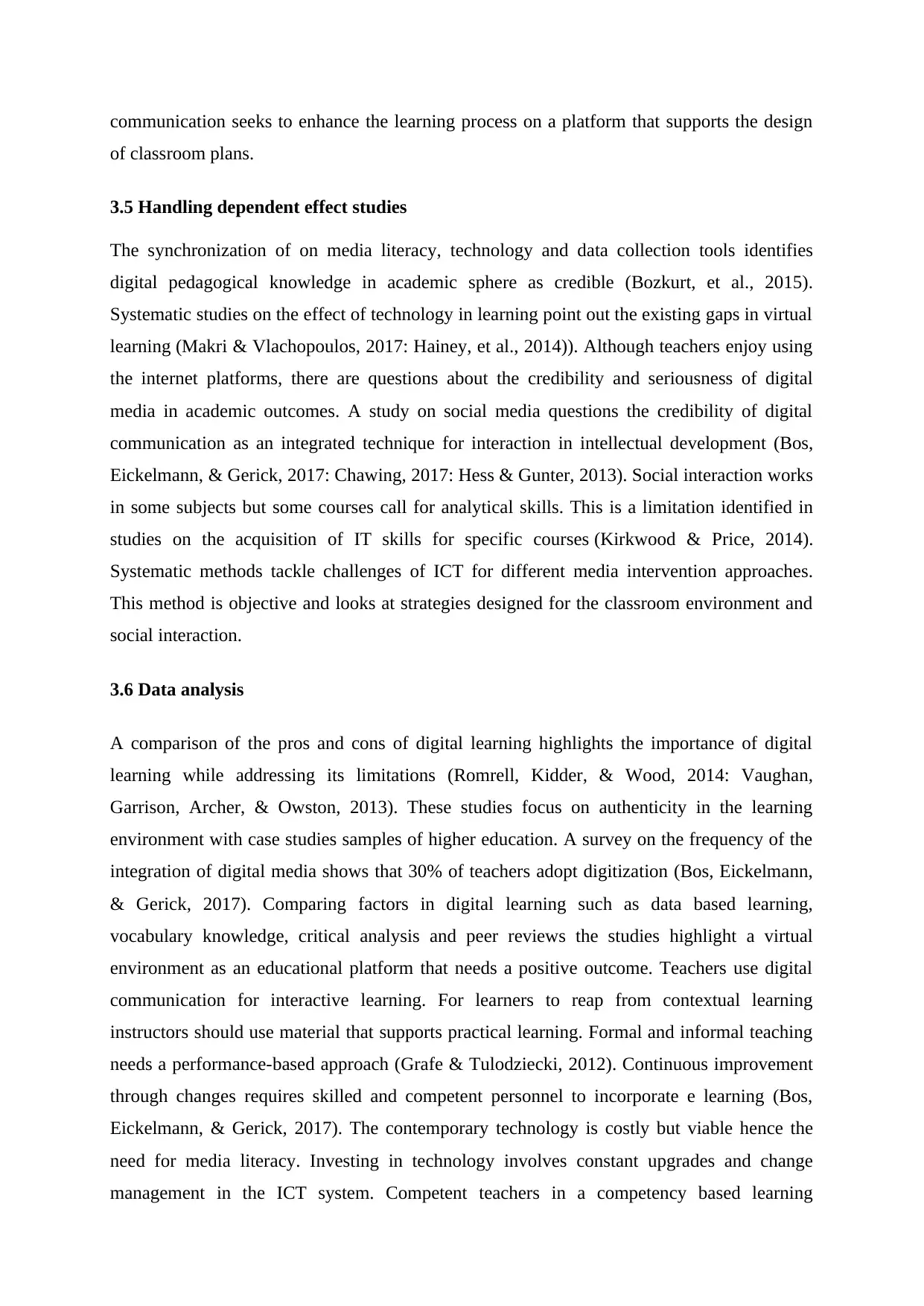
communication seeks to enhance the learning process on a platform that supports the design
of classroom plans.
3.5 Handling dependent effect studies
The synchronization of on media literacy, technology and data collection tools identifies
digital pedagogical knowledge in academic sphere as credible (Bozkurt, et al., 2015).
Systematic studies on the effect of technology in learning point out the existing gaps in virtual
learning (Makri & Vlachopoulos, 2017: Hainey, et al., 2014)). Although teachers enjoy using
the internet platforms, there are questions about the credibility and seriousness of digital
media in academic outcomes. A study on social media questions the credibility of digital
communication as an integrated technique for interaction in intellectual development (Bos,
Eickelmann, & Gerick, 2017: Chawing, 2017: Hess & Gunter, 2013). Social interaction works
in some subjects but some courses call for analytical skills. This is a limitation identified in
studies on the acquisition of IT skills for specific courses (Kirkwood & Price, 2014).
Systematic methods tackle challenges of ICT for different media intervention approaches.
This method is objective and looks at strategies designed for the classroom environment and
social interaction.
3.6 Data analysis
A comparison of the pros and cons of digital learning highlights the importance of digital
learning while addressing its limitations (Romrell, Kidder, & Wood, 2014: Vaughan,
Garrison, Archer, & Owston, 2013). These studies focus on authenticity in the learning
environment with case studies samples of higher education. A survey on the frequency of the
integration of digital media shows that 30% of teachers adopt digitization (Bos, Eickelmann,
& Gerick, 2017). Comparing factors in digital learning such as data based learning,
vocabulary knowledge, critical analysis and peer reviews the studies highlight a virtual
environment as an educational platform that needs a positive outcome. Teachers use digital
communication for interactive learning. For learners to reap from contextual learning
instructors should use material that supports practical learning. Formal and informal teaching
needs a performance-based approach (Grafe & Tulodziecki, 2012). Continuous improvement
through changes requires skilled and competent personnel to incorporate e learning (Bos,
Eickelmann, & Gerick, 2017). The contemporary technology is costly but viable hence the
need for media literacy. Investing in technology involves constant upgrades and change
management in the ICT system. Competent teachers in a competency based learning
of classroom plans.
3.5 Handling dependent effect studies
The synchronization of on media literacy, technology and data collection tools identifies
digital pedagogical knowledge in academic sphere as credible (Bozkurt, et al., 2015).
Systematic studies on the effect of technology in learning point out the existing gaps in virtual
learning (Makri & Vlachopoulos, 2017: Hainey, et al., 2014)). Although teachers enjoy using
the internet platforms, there are questions about the credibility and seriousness of digital
media in academic outcomes. A study on social media questions the credibility of digital
communication as an integrated technique for interaction in intellectual development (Bos,
Eickelmann, & Gerick, 2017: Chawing, 2017: Hess & Gunter, 2013). Social interaction works
in some subjects but some courses call for analytical skills. This is a limitation identified in
studies on the acquisition of IT skills for specific courses (Kirkwood & Price, 2014).
Systematic methods tackle challenges of ICT for different media intervention approaches.
This method is objective and looks at strategies designed for the classroom environment and
social interaction.
3.6 Data analysis
A comparison of the pros and cons of digital learning highlights the importance of digital
learning while addressing its limitations (Romrell, Kidder, & Wood, 2014: Vaughan,
Garrison, Archer, & Owston, 2013). These studies focus on authenticity in the learning
environment with case studies samples of higher education. A survey on the frequency of the
integration of digital media shows that 30% of teachers adopt digitization (Bos, Eickelmann,
& Gerick, 2017). Comparing factors in digital learning such as data based learning,
vocabulary knowledge, critical analysis and peer reviews the studies highlight a virtual
environment as an educational platform that needs a positive outcome. Teachers use digital
communication for interactive learning. For learners to reap from contextual learning
instructors should use material that supports practical learning. Formal and informal teaching
needs a performance-based approach (Grafe & Tulodziecki, 2012). Continuous improvement
through changes requires skilled and competent personnel to incorporate e learning (Bos,
Eickelmann, & Gerick, 2017). The contemporary technology is costly but viable hence the
need for media literacy. Investing in technology involves constant upgrades and change
management in the ICT system. Competent teachers in a competency based learning

institution make digital learning more effective. A result-oriented approach to strategic
learning is the right formula for implementing pedagogical learning.
4.0 Results and Discussion
Preliminary findings give a broad-based analysis of digital literacy of teachers and the use of
technologies in the classroom (Bozkurt et al, 2015). This focuses on:
The study design elements ( collaborative learning, experiments and reviews)
Publication type ( Journals on digital technology, research and review studies)
Discipline areas
Research validity
All studies pointed at multiple correlation between media competency and a combination of
digital applications. Among these was mobile technology (Adiguel & Avci, 2017), digital
applications (Hainey, et al., 2014: Chawinga, 2017: (Hess & Gunter, 2013) and technology
forms learning activities in formal and informal learning (Romrell, Kidder, & Wood, 2014:
Usher, 2018: Yu, 2012). Collaborative learning comes out in a study where student
participation features as a factor infuencing the instructors attitude (Adiguel & Avci, 2017).
Digital applications take up a contextual analysis in order to accommodate for subject specific
learning. Promoting efficiency through relevant material is a moderator across most of the
studies on experiential learning (Bozkurt, et al., 2015: Zhongliang, Pinjamaa, Mikkonen, &
Ammadd-ud-din, 2014). Understanding the target population is a limitation because it views
the learning environment from students and teachers perspective only.
Peer discussions on competency in media literacy incorporate the cultural perspective in order
to criticize the digital learning (Usher, 2018). A theme-based approach to the study looks at
institutions of higher learning and open learning system for a random effect. Analyzing digital
learning in the pedagogical setting summarizes the effect in order to avoid non-significant
results. Although there is evidence of publication bias, the metaanalysis a wide spread
analysis of reviews and experimental studies. Results from this metaanalysis provide a
framework designed for effective classroom performance. Digital learning offers a flexible
approach to learning and it includes task-based applications for different focus areas. The
inclusion of media literacy in the national curricula is due to the quality factor (Yu, 2012).
learning is the right formula for implementing pedagogical learning.
4.0 Results and Discussion
Preliminary findings give a broad-based analysis of digital literacy of teachers and the use of
technologies in the classroom (Bozkurt et al, 2015). This focuses on:
The study design elements ( collaborative learning, experiments and reviews)
Publication type ( Journals on digital technology, research and review studies)
Discipline areas
Research validity
All studies pointed at multiple correlation between media competency and a combination of
digital applications. Among these was mobile technology (Adiguel & Avci, 2017), digital
applications (Hainey, et al., 2014: Chawinga, 2017: (Hess & Gunter, 2013) and technology
forms learning activities in formal and informal learning (Romrell, Kidder, & Wood, 2014:
Usher, 2018: Yu, 2012). Collaborative learning comes out in a study where student
participation features as a factor infuencing the instructors attitude (Adiguel & Avci, 2017).
Digital applications take up a contextual analysis in order to accommodate for subject specific
learning. Promoting efficiency through relevant material is a moderator across most of the
studies on experiential learning (Bozkurt, et al., 2015: Zhongliang, Pinjamaa, Mikkonen, &
Ammadd-ud-din, 2014). Understanding the target population is a limitation because it views
the learning environment from students and teachers perspective only.
Peer discussions on competency in media literacy incorporate the cultural perspective in order
to criticize the digital learning (Usher, 2018). A theme-based approach to the study looks at
institutions of higher learning and open learning system for a random effect. Analyzing digital
learning in the pedagogical setting summarizes the effect in order to avoid non-significant
results. Although there is evidence of publication bias, the metaanalysis a wide spread
analysis of reviews and experimental studies. Results from this metaanalysis provide a
framework designed for effective classroom performance. Digital learning offers a flexible
approach to learning and it includes task-based applications for different focus areas. The
inclusion of media literacy in the national curricula is due to the quality factor (Yu, 2012).
⊘ This is a preview!⊘
Do you want full access?
Subscribe today to unlock all pages.

Trusted by 1+ million students worldwide
1 out of 18